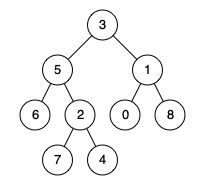236. 二叉树的最近公共祖先 java解决
给定一个二叉树, 找到该树中两个指定节点的最近公共祖先。
百度百科中最近公共祖先的定义为:“对于有根树 T 的两个节点 p、q,最近公共祖先表示为一个节点 x,满足 x 是 p、q 的祖先且 x 的深度尽可能大(一个节点也可以是它自己的祖先)。”
示例 1:
输入:root = [3,5,1,6,2,0,8,null,null,7,4], p = 5, q = 1
输出:3解释:节点 5 和节点 1 的最近公共祖先是节点 3 。
示例 2:
输入:root = [3,5,1,6,2,0,8,null,null,7,4], p = 5, q = 4
输出:5
解释:节点 5 和节点 4 的最近公共祖先是节点 5 。因为根据定义最近公共祖先节点可以为节点本身。
示例 3:
输入:root = [1,2], p = 1, q = 2
输出:1
提示:
树中节点数目在范围 [2, 105] 内。
-109 <= Node.val <= 109
所有 Node.val 互不相同 。
p != q
p 和 q 均存在于给定的二叉树中。
思路:
注意p,q必然存在树内, 且所有节点的值唯一!!! 递归思想, 对以root为根的(子)树进行查找p和q, 如果root == null || p || q 直接返回root 表示对于当前树的查找已经完毕, 否则对左右子树进行查找, 根据左右子树的返回值判断: 1. 左右子树的返回值都不为null, 由于值唯一左右子树的返回值就是p和q, 此时root为LCA 2. 如果左右子树返回值只有一个不为null, 说明只有p和q存在与左或右子树中, 最先找到的那个节点为LCA 3. 左右子树返回值均为null, p和q均不在树中, 返回null
代码:
/**
* Definition for a binary tree node.
* public class TreeNode {
* int val;
* TreeNode left;
* TreeNode right;
* TreeNode(int x) { val = x; }
* }
*/
class Solution {
public TreeNode lowestCommonAncestor(TreeNode root, TreeNode p, TreeNode q) {
if( root == null| root == p || root ==q )
return root;
TreeNode left = lowestCommonAncestor( root.left, p, q );
TreeNode right= lowestCommonAncestor( root.right, p, q );
if( left != null && right !=null ) //表示p和q分别位于root的左右子树中——>root就是LCA
return root;
if( left != null && right == null ) //表示p、q都是root的左子树中,且p、q其中一个就是left——>left就是LCA
return left;
else if( left == null && right != null ) //表示p、q都是root的右子树中,且p、q其中一个就是right——>right就是LCA
return right;
return null;
}
}
